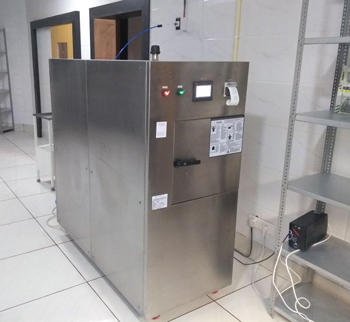Sterility assurance is a critical component in healthcare, pharmaceuticals, and medical device manufacturing. It ensures that products are free from harmful microorganisms, safeguarding patient safety and product efficacy. Ethylene Oxide (EO) sterilization is widely recognized as a leading method for achieving sterility, especially for heat-sensitive materials. To maximize the effectiveness of EO sterilization, robust quality control measures are essential.
This article explores how to optimize sterility assurance with EO sterilization by implementing advanced quality control measures, focusing on critical areas such as equipment, processes, and monitoring.
Understanding EO Sterilization
EO sterilization is a low-temperature process that uses ethylene oxide gas to eliminate bacteria, viruses, fungi, and spores. It is particularly suitable for materials sensitive to heat and moisture, such as plastics, polymers, and electronic components. EO sterilizers are extensively used in hospitals, medical colleges, and manufacturing facilities to ensure sterility across various applications.
Importance of Quality Control in EO Sterilization
Quality control in EO sterilization is essential to:
- Ensure Complete Sterility: Eliminate all microorganisms, including resistant spores.
- Maintain Compliance: Adhere to international sterilization standards.
- Protect Product Integrity: Prevent damage to delicate materials during sterilization.
- Enhance Patient Safety: Reduce the risk of infections caused by contaminated devices or supplies.
Key Quality Control Measures for EO Sterilization
Equipment Validation
EO sterilizers must be validated to ensure they meet performance standards. Validation includes:
- Installation Qualification: Verifying that the sterilizer is installed correctly.
- Operational Qualification: Testing the equipment to confirm it performs as intended under standard operating conditions.
- Performance Qualification: Ensuring the sterilizer achieves sterility across various load configurations and materials.
Process Monitoring
Monitoring the EO sterilization process is critical for achieving consistent results. Key parameters to track include:
- Temperature: Maintaining appropriate temperatures for effective sterilization.
- Gas Concentration: Ensuring sufficient ethylene oxide is introduced into the chamber.
- Exposure Time: Allowing adequate time for the gas to penetrate materials and eliminate microorganisms.
- Humidity: Optimizing moisture levels to enhance sterilization efficacy.
Routine Maintenance of EO Sterilizers
Regular maintenance ensures EO sterilizers operate at peak performance. Maintenance schedules should include:
- Inspection of seals and valves to prevent leaks.
- Calibration of sensors and control systems.
- Cleaning of chambers and gas circulation systems to maintain efficiency.
Enhancing Sterility Assurance with Advanced EO Sterilizers

Modern EO sterilizers come equipped with advanced features to enhance sterility assurance. These include:
- Automated Control Systems: Precise control over sterilization cycles and parameters.
- Real-Time Monitoring: Sensors that track temperature, pressure, and gas levels throughout the process.
- Data Logging:Automated recording of sterilization data for compliance and quality assurance.
- Durable Materials: Stainless steel EO sterilizers offer excellent resistance to corrosion and wear, ensuring longevity and reliability.
Quality Assurance in Hospital EO Sterilization
Hospitals rely on EO sterilizers to ensure the sterility of surgical instruments, diagnostic tools, and other critical equipment. Implementing quality control measures in hospital settings includes:
- Cycle Validation: Verifying that sterilization cycles meet the specific needs of the hospital’s equipment.
- Routine Testing: Using biological indicators to confirm sterility after each cycle.
- Staff Training: Ensuring operators understand sterilization protocols and quality control procedures.
Specialized EO Sterilizers for Medical Colleges
Medical colleges often require EO sterilizers to handle diverse sterilization needs, including educational equipment, lab tools, and diagnostic devices. Quality control in these settings focuses on:
- Adapting sterilization cycles for varied materials.
- Maintaining consistent sterilization standards across different departments.
- Incorporating advanced monitoring systems to track and document sterilization processes.
Partnering with EO Sterilizer Manufacturers
Collaborating with reputable EO sterilizer manufacturers is vital for optimizing sterility assurance. Leading manufacturers provide:
- Customized Solutions: Sterilizers tailored to specific requirements.
- Comprehensive Training: Operator training on sterilization best practices and quality control.
- After-Sales Support: Maintenance services and technical support to ensure equipment reliability.
Addressing Common Challenges in EO Sterilization
Residual Gas Removal
One challenge in EO sterilization is the presence of residual ethylene oxide gas on sterilized products. To address this:
- Implement extended aeration cycles.
- Use advanced aeration systems that efficiently remove residual gas.
Maintaining Compliance
Compliance with regulatory standards requires rigorous documentation and monitoring. Automated systems can simplify compliance by providing detailed records of sterilization cycles and validation tests.
Cost Management
While EO sterilization offers unparalleled efficacy, it can be cost-intensive. Optimizing cycle parameters and using energy-efficient sterilizers can help reduce operational costs.
Future Trends in EO Sterilization Quality Control
The future of EO sterilization quality control lies in technological innovation. Emerging trends include:
- Integration with IoT: Enabling remote monitoring and diagnostics of sterilization processes.
- Artificial Intelligence: Using AI to optimize cycle parameters and predict maintenance needs.
- Sustainability: Developing eco-friendly sterilizers that minimize ethylene oxide emissions and energy consumption.
Conclusion
Optimizing sterility assurance with EO sterilization requires a comprehensive approach to quality control. From equipment validation and process monitoring to advanced sterilizers and staff training, every step is crucial to ensuring the safety and efficacy of sterilized products. By implementing robust quality control measures and embracing technological advancements, healthcare facilities, medical colleges, and manufacturers can enhance their sterilization processes, ensuring the highest standards of hygiene and patient safety.






